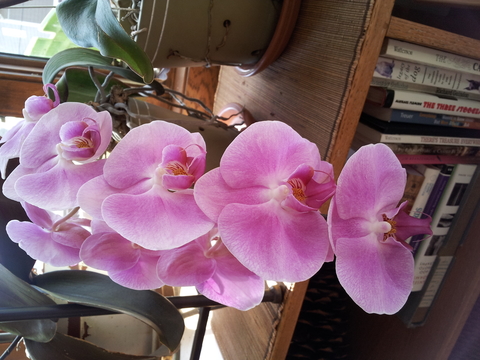Keeping your houseplant investment healthy
UNIVERSITY OF MINNESOTA EXTENSION - www.extension.umn.edu
Pink moth orchid (Phalaenopsis)
People love houseplants. They bring live greenery into homes, offices and classrooms. Plants add color, sometimes fragrance and connect us to nature. Some are said to improve air quality. There is even a new term, “plant parent,” to describe how people feel connected to their plants emotionally.
Many times, I have fielded questions from the distraught houseplant owner afraid they have killed (or are killing) a favorite houseplant.
Houseplants are part of our economy
The Consumer Houseplant Purchasing Report 2021 says that people will spend anywhere from $20.40 (“a bargain”) to $37.70 (“getting expensive”) on a small flowering plant, the most commonly purchased houseplant.
According to the report, plant owners range in age, gender and geographic location, and most people own 1 to 5 plants.
The research team reported people spent 31% more time caring for their houseplants in 2020 than they did in 2019 and plan to continue this trend going forward.
Clearly people spend a lot of time and money on houseplants, and keeping them healthy and alive is important economically as well as emotionally.
So how can you protect your investment
Don’t make assumptions about how plants grow. We take time to learn how to operate appliances, maintain cars, use tools, even launder clothes. Take the same approach with houseplants. Learn about plants’ native habitats and growing requirements.
Here’s an example. Moth orchids (Phalaenopsis) are plentiful in the market. They can be purchased at garden centers, big box stores, home stores, even grocery stores. They are long-lived, exotic beauties that make a great addition to your home or a gift for someone special. Most cost around $15 to $25.
Moth orchids are epiphytes, a plant that grows on another plant but is not parasitic. In nature, they cling to other plants like shade trees with their thick air roots and take up moisture and nutrients from the plant surface, rain and air. Knowing that a moth orchid naturally grows with its roots out in the air helps explain why moth orchids should dry out between waterings vs. being constantly wet. It also helps to explain why we grow them in a soil-less bark mix, not in potting soil, and why those crazy silver-green roots grow up and out into the air.
- When watering a moth orchid, simulate how it naturally gets moisture by setting it in a sink and drenching it with a solution of untreated water plus orchid fertilizer.
- Allow the plant to drain before placing it back in its growing location.
Taking the time to learn about how your houseplants grow saves dollars and makes sense. Invest time into learning about your plant.
- Read the plant tag.
- Talk to garden center staff.
- Read articles, books and web resources like UMN Extension Yard & Garden.
- Visit the Minnesota Landscape Arboretum.
- Take classes.
- And ask a Master Gardener.

